2023 SUBARU BRZ fuel type
[x] Cancel search: fuel typePage 189 of 432
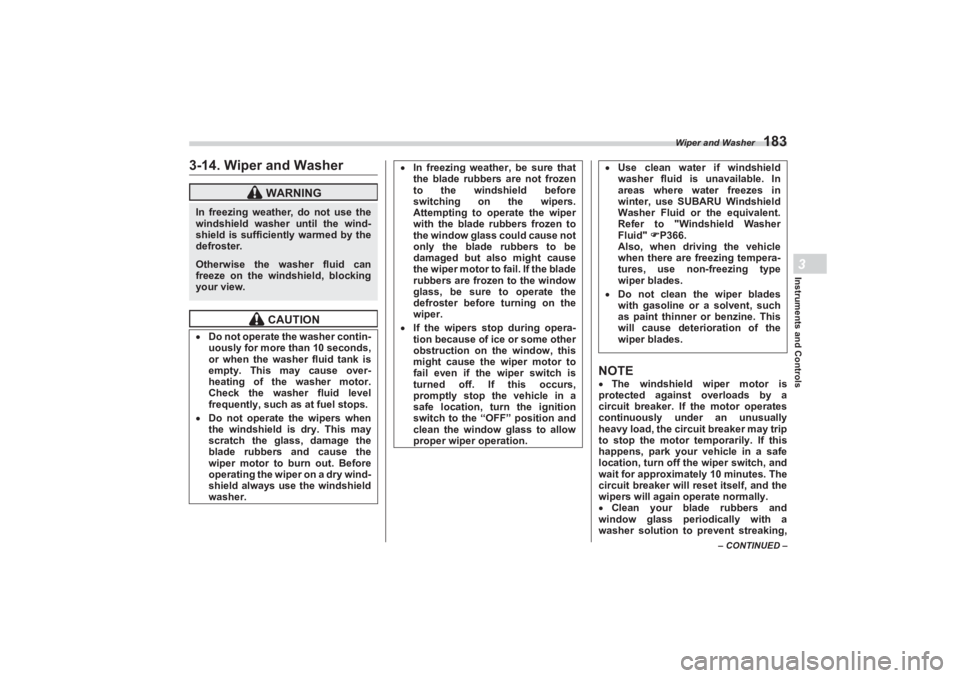
Wiper and Washer
183
Instruments and Controls3
– CONTINUED –
3-14. Wiper and Washer
NOTEThe windshield wiper motor is
protected against overloads by a
circuit breaker. If the motor operates
continuously under an unusually
heavy load, the circuit breaker may trip
to stop the motor temporarily. If this
happens, park your vehicle in a safe
location, turn off th e wiper switch, and
wait for approximately 10 minutes. The
circuit breaker will reset itself, and the
wipers will again operate normally.
Clean your blade rubbers and
window glass periodically with a
washer solution to prevent streaking,
WARNING
In freezing weather, do not use the
windshield washer until the wind-
shield is sufficiently warmed by the
defroster.Otherwise the washer fluid can
freeze on the windshield, blocking
your view.
CAUTION
Do not operate the washer contin-
uously for more than 10 seconds,
or when the washer fluid tank is
empty. This may cause over-
heating of the washer motor.
Check the washer fluid level
frequently, such as at fuel stops. Do not operate the wipers when
the windshield is dry. This may
scratch the glass, damage the
blade rubbers and cause the
wiper motor to bu rn out. Before
operating the wiper on a dry wind-
shield always use the windshield
washer.
In freezing weather, be sure that
the blade rubbers are not frozen
to the windshield before
switching on the wipers.
Attempting to op erate the wiper
with the blade rubbers frozen to
the window glass could cause not
only the blade rubbers to be
damaged but also might cause
the wiper motor to fail. If the blade
rubbers are frozen to the window
glass, be sure to operate the
defroster before turning on the
wiper. If the wipers stop during opera-
tion because of ice or some other
obstruction on the window, this
might cause the wiper motor to
fail even if the wiper switch is
turned off. If this occurs,
promptly stop the vehicle in a
safe location, turn the ignition
switch to the “OFF” position and
clean the window glass to allow
proper wiper operation.
Use clean water if windshield
washer fluid is unavailable. In
areas where water freezes in
winter, use SUBARU Windshield
Washer Fluid or the equivalent.
Refer to "Windshield Washer
Fluid" P366.
Also, when driving the vehicle
when there are freezing tempera-
tures, use non-freezing type
wiper blades. Do not clean the wiper blades
with gasoline or a solvent, such
as paint thinner or benzine. This
will cause deterioration of the
wiper blades.
BRZ_U.book 183 ページ 2022年3月29日 火曜日 午後3時59分
Page 229 of 432
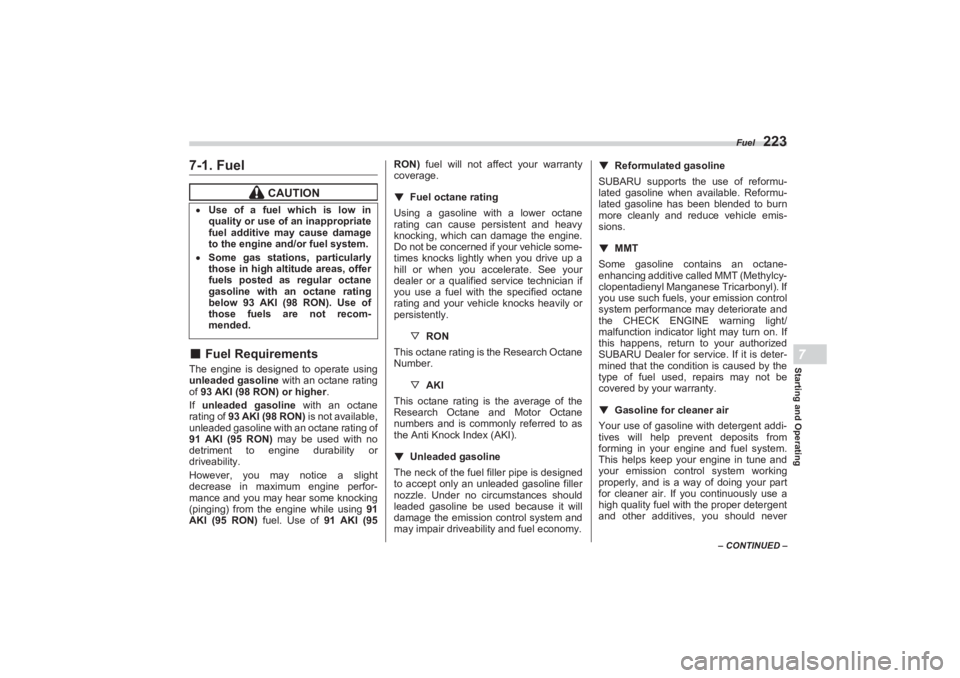
Fuel
223
Starting and Operating7
– CONTINUED –
7-1. Fuel■Fuel RequirementsThe engine is designed to operate using
unleaded gasoline with an octane rating
of 93 AKI (98 RON) or higher .
If unleaded gasoline with an octane
rating of 93 AKI (98 RON) is not available,
unleaded gasoline with an octane rating of
91 AKI (95 RON) may be used with no
detriment to engine durability or
driveability.
However, you may notice a slight
decrease in maximum engine perfor-
mance and you may hear some knocking
(pinging) from the engine while using 91
AKI (95 RON) fuel. Use of 91 AKI (95 RON)
fuel will not affect your warranty
coverage.
▼ Fuel octane rating
Using a gasoline with a lower octane
rating can cause persistent and heavy
knocking, which can damage the engine.
Do not be concerned if your vehicle some-
times knocks lightly when you drive up a
hill or when you accelerate. See your
dealer or a qualified service technician if
you use a fuel with the specified octane
rating and your vehi cle knocks heavily or
persistently.
▽RON
This octane rating is the Research Octane
Number.
▽AKI
This octane rating is the average of the
Research Octane and Motor Octane
numbers and is commonly referred to as
the Anti Knock Index (AKI).
▼ Unleaded gasoline
The neck of the fuel filler pipe is designed
to accept only an unleaded gasoline filler
nozzle. Under no circumstances should
leaded gasoline be used because it will
damage the emission control system and
may impair driveability and fuel economy. ▼
Reformulated gasoline
SUBARU supports the use of reformu-
lated gasoline when available. Reformu-
lated gasoline has been blended to burn
more cleanly and reduce vehicle emis-
sions.
▼ MMT
Some gasoline contains an octane-
enhancing additive called MMT (Methylcy-
clopentadienyl Manganese Tricarbonyl). If
you use such fuels, your emission control
system performance may deteriorate and
the CHECK ENGINE warning light/
malfunction indicator light may turn on. If
this happens, return to your authorized
SUBARU Dealer for service. If it is deter-
mined that the condition is caused by the
type of fuel used, repairs may not be
covered by your warranty.
▼ Gasoline for cleaner air
Your use of gasoline with detergent addi-
tives will help prevent deposits from
forming in your engi ne and fuel system.
This helps keep your engine in tune and
your emission cont rol system working
properly, and is a way of doing your part
for cleaner air. If you continuously use a
high quality fuel with the proper detergent
and other additives, you should never
CAUTION
Use of a fuel which is low in
quality or use of an inappropriate
fuel additive may cause damage
to the engine and/or fuel system. Some gas stations, particularly
those in high altitude areas, offer
fuels posted as regular octane
gasoline with an octane rating
below 93 AKI (98 RON). Use of
those fuels are not recom-
mended.
BRZ_U.book 223 ページ 2022年3月29日 火曜日 午後3時59分
Page 338 of 432
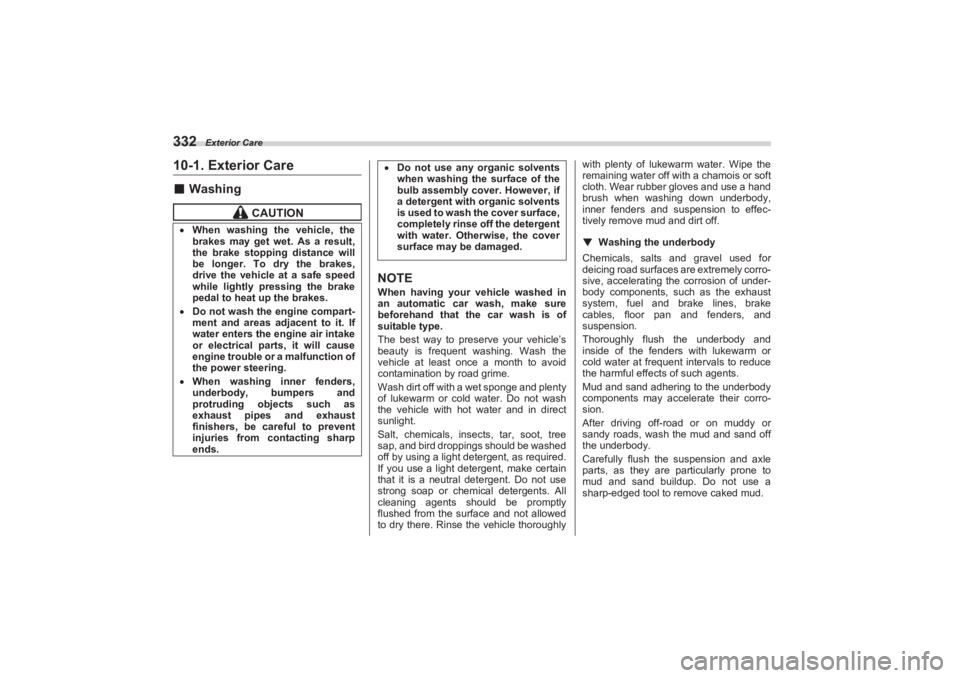
Exterior Care
33210-1. Exterior Care■Washing
NOTE
When having your vehicle washed in
an automatic car wash, make sure
beforehand that the car wash is of
suitable type.
The best way to preserve your vehicle’s
beauty is frequent washing. Wash the
vehicle at least once a month to avoid
contamination by road grime.
Wash dirt off with a wet sponge and plenty
of lukewarm or cold water. Do not wash
the vehicle with hot water and in direct
sunlight.
Salt, chemicals, insects, tar, soot, tree
sap, and bird droppings should be washed
off by using a light detergent, as required.
If you use a light detergent, make certain
that it is a neutral detergent. Do not use
strong soap or chemical detergents. All
cleaning agents should be promptly
flushed from the surface and not allowed
to dry there. Rinse the vehicle thoroughly with plenty of lukewarm water. Wipe the
remaining water off with a chamois or soft
cloth. Wear rubber gloves and use a hand
brush when washing down underbody,
inner fenders and suspension to effec-
tively remove mud and dirt off.
▼ Washing the underbody
Chemicals, salts and gravel used for
deicing road surfaces are extremely corro-
sive, accelerating the corrosion of under-
body components, such as the exhaust
system, fuel and brake lines, brake
cables, floor pan and fenders, and
suspension.
Thoroughly flush the underbody and
inside of the fenders with lukewarm or
cold water at frequent intervals to reduce
the harmful effects of such agents.
Mud and sand adhering to the underbody
components may accelerate their corro-
sion.
After driving off-road or on muddy or
sandy roads, wash the mud and sand off
the underbody.
Carefully flush the suspension and axle
parts, as they are particularly prone to
mud and sand buildup. Do not use a
sharp-edged tool to remove caked mud.
CAUTION
When washing the vehicle, the
brakes may get wet. As a result,
the brake stopping distance will
be longer. To dry the brakes,
drive the vehicle at a safe speed
while lightly pressing the brake
pedal to heat up the brakes. Do not wash the engine compart-
ment and areas adjacent to it. If
water enters the engine air intake
or electrical parts, it will cause
engine trouble or a malfunction of
the power steering. When washing inner fenders,
underbody, bumpers and
protruding objects such as
exhaust pipes and exhaust
finishers, be careful to prevent
injuries from contacting sharp
ends.
Do not use any organic solvents
when washing the surface of the
bulb assembly cover. However, if
a detergent with organic solvents
is used to wash the cover surface,
completely rinse off the detergent
with water. Otherwise, the cover
surface may be damaged.
BRZ_U.book 332 ページ 2022年3月29日 火曜日 午後3時59分
Page 342 of 432
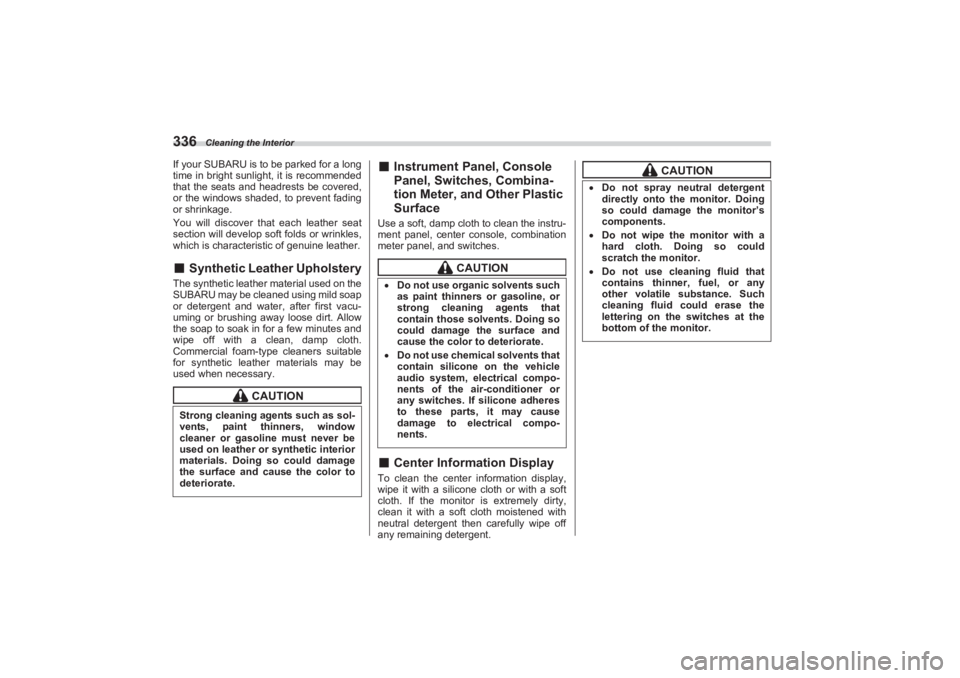
Cleaning the Interior
336If your SUBARU is to be parked for a long
time in bright sunlight, it is recommended
that the seats and headrests be covered,
or the windows shaded, to prevent fading
or shrinkage.
You will discover that each leather seat
section will develop so ft folds or wrinkles,
which is characteristic of genuine leather.■ Synthetic Leather UpholsteryThe synthetic leather material used on the
SUBARU may be cleaned using mild soap
or detergent and water, after first vacu-
uming or brushing away loose dirt. Allow
the soap to soak in for a few minutes and
wipe off with a clean, damp cloth.
Commercial foam-type cleaners suitable
for synthetic leather materials may be
used when necessary.
■ Instrument Panel, Console
Panel, Switches, Combina -
tion Meter, and Other Plastic
SurfaceUse a soft, damp cloth to clean the instru-
ment panel, center console, combination
meter panel, and switches.■ Center Information DisplayTo clean the center information display,
wipe it with a silicone cloth or with a soft
cloth. If the monitor is extremely dirty,
clean it with a soft cloth moistened with
neutral detergent then carefully wipe off
any remaining detergent.
CAUTION
Strong cleaning agents such as sol-
vents, paint thinners, window
cleaner or gasoline must never be
used on leather or synthetic interior
materials. Doing so could damage
the surface and cause the color to
deteriorate.
CAUTION
Do not use organic solvents such
as paint thinners or gasoline, or
strong cleaning agents that
contain those solvents. Doing so
could damage the surface and
cause the color to deteriorate. Do not use chemical solvents that
contain silicone on the vehicle
audio system, electrical compo-
nents of the air-conditioner or
any switches. If silicone adheres
to these parts, it may cause
damage to electrical compo-
nents.
CAUTION
Do not spray neutral detergent
directly onto the monitor. Doing
so could damage the monitor’s
components. Do not wipe the monitor with a
hard cloth. Doing so could
scratch the monitor. Do not use cleaning fluid that
contains thinner, fuel, or any
other volatile substance. Such
cleaning fluid could erase the
lettering on the switches at the
bottom of the monitor.
BRZ_U.book 336 ページ 2022年3月29日 火曜日 午後3時59分
Page 352 of 432
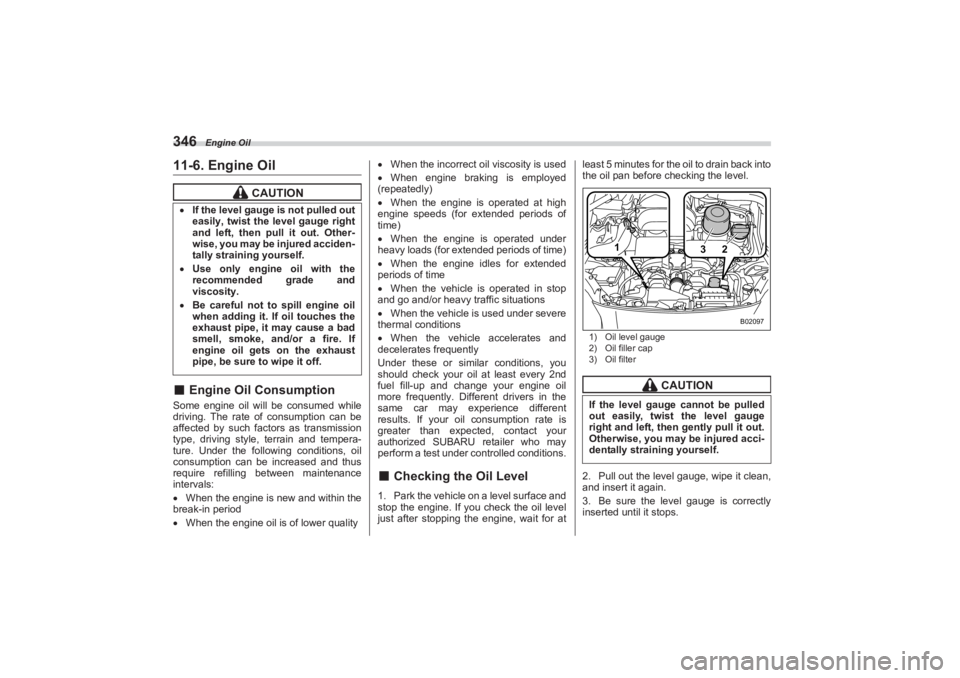
Engine Oil
34611-6. Engine Oil■Engine Oil ConsumptionSome engine oil will be consumed while
driving. The rate of consumption can be
affected by such factors as transmission
type, driving style, terrain and tempera-
ture. Under the followi ng conditions, oil
consumption can be increased and thus
require refilling between maintenance
intervals:
When the engine is new and within the
break-in period
When the engine oil is of lower quality
When the incorrect oil viscosity is used
When engine braking is employed
(repeatedly)
When the engine is operated at high
engine speeds (for extended periods of
time)
When the engine is operated under
heavy loads (for extended periods of time)
When the engine idles for extended
periods of time
When the vehicle is operated in stop
and go and/or heavy traffic situations
When the vehicle is used under severe
thermal conditions
When the vehicle accelerates and
decelerates frequently
Under these or similar conditions, you
should check your oil at least every 2nd
fuel fill-up and change your engine oil
more frequently. Different drivers in the
same car may experience different
results. If your oil consumption rate is
greater than expected, contact your
authorized SUBARU retailer who may
perform a test under controlled conditions.
■ Checking the Oil Level1. Park the vehicle on a level surface and
stop the engine. If you check the oil level
just after stopping the engine, wait for at least 5 minutes for the oil to drain back into
the oil pan before checking the level.
1) Oil level gauge
2) Oil filler cap
3) Oil filter2. Pull out the level gauge, wipe it clean,
and insert it again.
3. Be sure the level gauge is correctly
inserted until it stops.
CAUTION
If the level gauge is not pulled out
easily, twist the level gauge right
and left, then pull it out. Other-
wise, you may be injured acciden-
tally straining yourself. Use only engine oil with the
recommended grade and
viscosity. Be careful not to spill engine oil
when adding it. If oil touches the
exhaust pipe, it may cause a bad
smell, smoke, and/or a fire. If
engine oil gets on the exhaust
pipe, be sure to wipe it off.
CAUTION
If the level gauge cannot be pulled
out easily, twist the level gauge
right and left, then gently pull it out.
Otherwise, you may be injured acci-
dentally straining yourself.
1
3
2
B02097
BRZ_U.book 346 ページ 2022年3月29日 火曜日 午後3時59分
Page 389 of 432
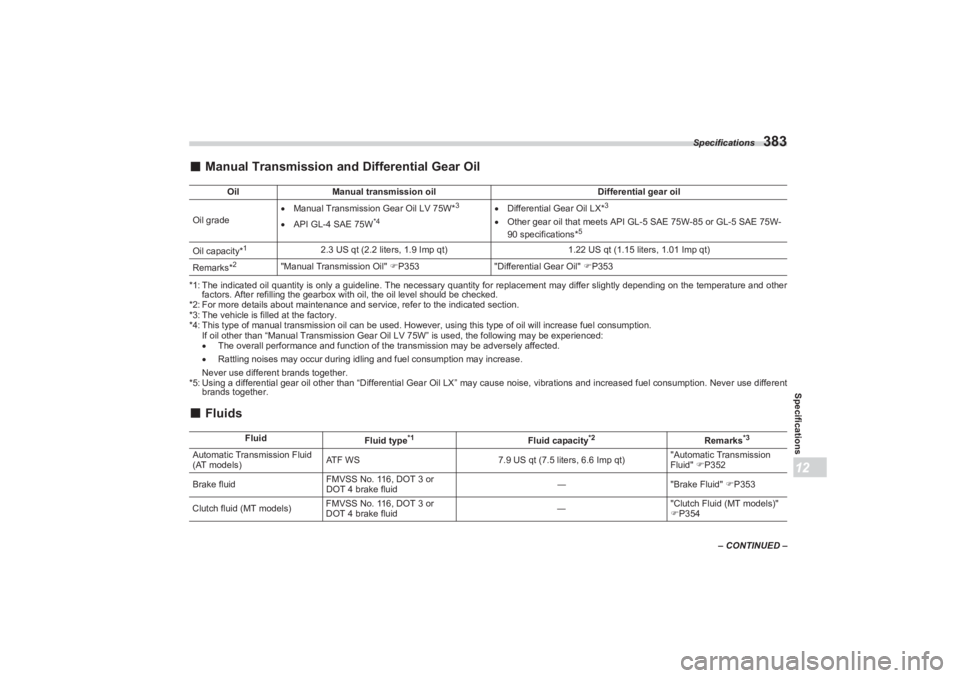
Specifications
383
Specifications12
– CONTINUED –
■Manual Transmission and Differential Gear Oil*1: The indicated oil quantity is only a guideline. The necessary quantity for replacement may differ slightly depending on the temperature and other
factors. After refilling the gearbox wi th oil, the oil level should be checked.
*2: For more details about maintenance and service, refer to the indicated section.
*3: The vehicle is filled at the factory.
*4: This type of manual transmission oil can be used. However, using this type of oil will increase fuel consumption.
If oil other than “Manual Transmission Gear Oil LV 75W” is used, the following may be experienced:
The overall performance and function of the transmission may be adversely affected.
Rattling noises may occur during id ling and fuel consumption may increase.
Never use different brands together.
*5: Using a differential gear oil other than “D ifferential Gear Oil LX” may cause noise, vibrations and increased fuel consumpti on. Never use different
brands together.■ Fluids
Oil Manual transmission oil Differential gear oil
Oil grade
Manual Transmission Gear Oil LV 75W*
3
API GL-4 SAE 75W
*4
Differential Gear Oil LX*
3
Other gear oil that meets API GL-5 SAE 75W-85 or GL-5 SAE 75W-
90 specifications*
5
Oil capacity*
1
2.3 US qt (2.2 liters, 1.9 Imp qt) 1.22 US qt (1.15 liters, 1.01 Imp qt)
Remarks*
2
"Manual Transmission Oil" P353 "Differential Gear Oil" P353
Fluid Fluid type
*1
Fluid capacity
*2
Remarks
*3
Automatic Transmission Fluid
(AT models) ATF WS
7.9 US qt (7.5 liters, 6.6 Imp qt)"Automatic Transmission
Fluid"
P352
Brake fluid FMVSS No. 116, DOT 3 or
DOT 4 brake fluid
―
"Brake Fluid" P353
Clutch fluid (MT models) FMVSS No. 116, DOT 3 or
DOT 4 brake fluid
―"Clutch Fluid (MT models)"
P354
BRZ_U.book 383 ページ 2022年3月29日 火曜日 午後3時59分